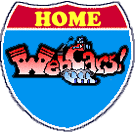Wheels
Wheels can be divided into two categories: painted and non painted.
Both have one thing in common: brake dust. Brake dust is the grayish material that coats the exterior of a wheel and goes a long way towards detracting from their appearance. The source of brake dust is is the brake pads; as they wear, they turn into brake dust.
Special wheel cleaners are available that are designed to remove the brake dust and can be purchased to accommodate painted and not painted wheels.
If you are not sure if you have painted wheels, take some light polish and put it on a white towel (or another color if the wheel is white) and rub it on a small area of the wheel. If the surface of the rag is black you have a non painted (metal surface) wheel. If the towel is the color of the wheel, you have a painted wheel. If the towel is not black but the wheel appears to have a metal surface, you most likely have a clear coated wheel. Clear coated wheels can be treated just like painted wheels.
If you do have a non painted wheel, it is important to determine the material that the wheel is made of so you'll use the proper cleaner. The surface and how it is treated can make a difference. For example chromed, brushed, machined, anodized or polished aluminum wheels have different requirements. Consult the owners manual if the wheels are factory supplied for the proper cleaner to use. If the wheels are aftermarket, ask the wheel manufacturer.
It is best to separate wheel cleaning from the washing of the surface of the car. There are three reasons for this:
- Avoiding scratches. The wheels and tires are likely to contain large dirt particles. If you use the same wash mit or sponge, the dirt particles could transfer from the wheels to the paint surface, causing scratches.
- Wheels are generally dirtier than your paint surface, and so they may require more aggressive cleaning.
- Cleaning your wheels separately allows you to use a higher concentration of detergent; you can also use dish detergent which you would not use on the paint surface because it will remove the wax.
We recommend that you wash, rinse and dry each wheel separately. Although it may seem inefficient, water spots will not have a chance to appear and you'll be able to quickly tend to the adjacent paint surfaces of the car which will be affected with the wheel washing.
Remove hubcaps or any other part of the wheel that is removable and wash them separately. Wash the inside of the hubcap too as any dirt, brake dust etc. inside can rinse out and appear on the wheel as you rinse the car or wheel.
If you are looking to do a high level detail job (for example if you are entering a car show) consider removing the wheels for cleaning. This will enable you to clean the back of the wheel and other areas that although they are hard to reach otherwise, they are still visible.
Tires
It is easiest to wash the tire along with the wheel. There are a number of good tire treatment products available which will do a fine job. Apply according to the manufacturers directions. Wipe the tire with a light colored towel. If the towel has black residue, give it another treatment. You could end up doing this several times as layers of brake dust and dead rubber come off.
Do not attempt to treat the tread surface of a tire. It won't do much good as it will soon degrade when the car is driven. It could also affect the performance of the tire.

|

















